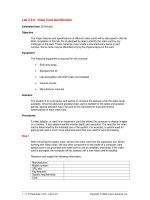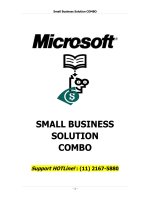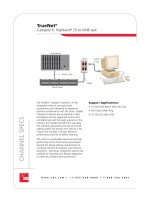Tài liệu Startup ppt
Bạn đang xem bản rút gọn của tài liệu. Xem và tải ngay bản đầy đủ của tài liệu tại đây (2.48 MB, 195 trang )
For your convenience Apress has placed some of the front
matter material after the index. Please use the Bookmarks
and Contents at a Glance links to access them.
Contents
About the Author v
Acknowledgments vi
Preface vii
Chapter 1: Setting the Stage 1
Chapter 2: Core Lessons 27
Chapter 3: Marketing 61
Chapter 4: Building a Team 99
Chapter 5: Communication Matters 119
Chapter 6: Strategic Thinking 131
Chapter 7: Exiting Your Business 163
Index 177
C H A P T E R
1
Setting the
Stage
As we get started on this business adventure together, I want to share with
you what I mean when I use the word entrepreneur. The following definition
sums it up succinctly:
An entrepreneur is a risk-taker who invests his time, energy, and/or
capital to create a new product, process, or service that has resonance
within a given community.
Let’s look at the implications of this idea.
Entrepreneurship and Resonance
Let’s flesh this out a bit. An entrepreneur needs to find a way to interact with
people (preferably lots of people) in a way that resonates with them. This
means that the product or service attracts their participation and buy-in. In
physics, resonance occurs when a pattern in one system causes surrounding
systems to begin to vibrate or move in a similar pattern. This is exactly what
entrepreneurs do. This can be social entrepreneurship—for example, Presi-
dent Jimmy Carter working with Habitat for Humanity (lots of resonance and
buy-in there). However, it is usually business oriented, such as Jeff Bezos’ Ama-
zon.com. His creation certainly resonates with people, and they demonstrate
this with their purchasing power. They keep going back to Amazon again and
again.
Chapter 1 | Setting the Stage
2
Another great example of buy-in and resonance can be seen in San Francisco
with Blue Bottle Coffee Company. It is an immensely popular coffee business,
in an already crowded market. Even with Starbucks and numerous other op-
tions available in the marketplace, the 30-minute line of devoted coffee drink-
ers queued up every morning stands as a literal testament to the resonance
the company created. Where did this resonance come from? A high-quality
product, delivered in a way that people want. “It's really about an appreciation
for unnecessary beauty,” founder James Freeman says, “and a willingness to work
for it.”
1
■ Note An entrepreneur is a builder of resonance.
In order to develop resonance, a startup has to start with a product or
service. Selecting that starting point requires a few perspectives that are vital
and definitely worth recognizing. Let’s look at each in turn.
Entrepreneurs Create Something New
Entrepreneurship always starts with a proposition: you are going to solve
someone’s problem—specifically:
• You have information or insight that other people don’t
have.
• You have a unique product.
• You will deliver an existing product to a group that does
not have it.
• You will deliver an existing product in a new way, which
could be faster, cheaper, or better.
1
Fortune magazine, September 26, 2011
Startup
3
It Is Compelling
The business idea is important enough that, when properly executed, it will
trigger a specific customer group to reach into their pockets, pull out their
money, and pay you for it.
You Can Scale It
Does your idea structurally have enough potential transactions to make
enough money? If you buckle down tight and build this business, identify how
big it can get, and what resources you will need to get there.
If you are marketing your own time as a consultant, for instance, is it scalable
to your needs? You only have 24 hours a day to sell—and will occasionally
need to sleep and eat. So your inventory of product is limited.
If you are selling products, what are the physical limitations on how much
product you can get your hands on and connect with customers? These in-
clude the following:
• Product availability: If you are selling large, complex prod-
ucts, how many can you actually manufacture per year?
• Demand: What will the market bear in terms of transac-
tions that you can compete for?
Play it out, and see what the outer bounds of your idea look like in terms of
scale, product availability, and demand of the market.
You Can Control It
Having chosen a product or service, can you control the vital elements of the
business? These include things like access to merchandise, licensing, and so
forth. This is a structural aspect of the business that you are responsible for
figuring out before you jump in.
• What political, legislative, or economic factors are you de-
pending on to stay in business? For example, building a ve-
hicle emissions testing device as a core product is highly
dependent on having states legislate that such testing is
required.
Chapter 1 | Setting the Stage
4
• If your chosen business model is dependent on a third-
party license or company, what are the risks associated
with that dependency? What guarantees do you have for
the long-term stability and availability of that relationship?
For example, becoming an independent agent of an insur-
ance company creates a clear dependence on that com-
pany’s strength and evolving reputation.
• An example of this is the current fad of serve-yourself
yogurt shops, which is hitting hard in Austin, Texas. A
dozen such shops have opened there in the last 18
months. These market players cannot control how many
more of these will pop up and eat up local market share
from them—they just have to watch what happens.
• An example of “control done right” is a car dealership.
When you are lucky enough to get the go-ahead to open a
Honda or Lexus dealership, you are given a region wherein
only you will represent the brand. That is a powerful type
of control.
• If you are licensing a solar technology from China to build
a customer base in Europe, can you negotiate an exclusive
right to do so? Or will any company with an interest in the
technology be able to do the same thing?
• If you have a novel technology of some kind, can you get
patents to cover your invention and make it defensible?
Exercise: Get a whiteboard and visually draw out the relationships between
your idea, the customers, the dependencies (licenses, product, sales channels),
your staff, and any other details you can think of. Become fluent in the story
and explore the relationships thoroughly before committing to any particular
strategy or business model.
_________________
Startup
5
A Ticket to the Game
Most folks think that building a product or packaging a great service is the
hardest part of becoming a successful business owner. The thought is some-
thing along the lines of, “If we can just build the web site, or open the restau-
rant, or create the widget—then we are going to start making money!”
Building it, opening it, or inventing it is often the easy part. The hard part is
usually what comes next—connecting with customers, communicating your
value, and convincing them to pull out their wallets to give you money.
Figuring out exactly how you will connect the product with enough customers in
a short enough time span so that you survive, and grow to thrive—that’s
where the real work awaits.
To be successful in business you do have to have a great product; a product
that is developed and ready to go. This alone takes a great deal of time, effort,
and investment. However, this great achievement is nothing more than a ticket
to the game. It is the cost of admission that allows you to enter the coliseum
and fight the battle for the attention of your customers. And this is competi-
tion against those who are already in the market trying to make a dollar in
your chosen space. This process of connecting your idea with customers is
your business. Not only that, you have to connect your idea given a rigid set of
constraints:
• Time: How long can you go before you establish a base
level of product sales?
• Money: How much money you have for marketing deter-
mines what strategies are available to you. Never use your
whole budget for product development—make sure to
allocate a significant amount of money for the marketing
effort.
• Product Category Awareness: Is there already awareness in
the market for what your category of product does?
• Brand Awareness: Do you have any market awareness asso-
ciated with your particular product or service that you can
leverage? Are you starting from scratch?
• Competitive Messaging: How much messaging is already be-
ing directed at your customers by competitors?
Chapter 1 | Setting the Stage
6
• Non-competitive Messaging: How heavily is your customer
base being messaged by other businesses that are not re-
lated to what you are offering? (You are in competition
with them, too, when you are trying to get a customer’s
attention.)
Takeaways: Building a product is nothing more than a step in your business.
For most companies, the hard part—the business part—is the process of con-
necting that product or service with customers given a limited set of re-
sources.
_________________
Nobody Cares About Your Business
When consulting with entrepreneurs that are struggling to get a business off
the ground, I often end up telling them this:
I read a great book on starting your own business. It’s the most
important book on the subject you could ever read—and it only had
two words in it.
Those two words were “nobody cares.”
To close the story and make the point, I tell them that as an entrepreneur,
your entire job is to make those two tiny, awful words wrong.
That’s it. Make people care about what you are doing.
The fact of the matter is that at first, people won’t care. People are busy.
People won’t know who you are when you start out, and they won’t go out of
their way to find out. As you create a business, and move beyond your prod-
uct to the point where you are figuring out how to connect your product with
the market, you realize that the whole purpose behind your effort is to get
people to care about what you do. If you are in the computer business, it is
not just about computers. If you are in the pizza business, it is not just about
pizza. The best product in the world is just a starting point, and it won’t make
you a dollar unless you can figure out how to make that product relevant to
Startup
7
the lives of your customers and get them to understand that relevance. Having
a great product helps, but that alone is not enough.
This bias toward customer indifference is a reality of the market. But to tell
you the truth, I like the fact that getting into markets is tough, because that
means that it is tough for my competitors too, and will serve to keep the folks in
your market that aren’t smart enough or fast enough from hogging the swing
set for too long.
_________________
What Is a Business?
Too often, business owners, managers, and decision-makers get fooled by the
way they use language into thinking that their business is a “thing.” It is not. It
is convenient and even necessary to use a noun to refer to your business when
communicating with people, but when you visualize it for yourself, make sure
you don’t ever do so. One of the lessons I have brought along to all of the
companies that I have worked at and consulted for is the following:
Your business is not a noun. It is a verb. It is a “happening” and a
“doing.” It is nothing less than the sum total of the actions and
thoughts of every employee and customer. It is the result-in-motion of
all of the things that the people who participate in your business do
each and every day.
Mentally framing your business in this way is an easy and useful step toward
understanding it and how its complexity is organized between ideas, your staff,
your customers, and the wider market. If you are visualizing the business as a
noun (an object of some kind), your model of understanding is inherently
missing much of its complexity. By promoting your visualization from a noun
(static) to a verb, you automatically give yourself a much more complex mod-
eling paradigm. You will immediately get closer to the reality of dance-like
complexity found in all businesses as they grow and operate.
Chapter 1 | Setting the Stage
8
_________________
The Boat
Most people are employees working for other people. This employment may
chafe them a bit from time to time, but they are sacrificing a bit of freedom for
the stability. They usually aspire to become leaders in their environment, in
part to grow their salary, and in part to ease the chafing—and to have more
control over their own lives. Inherent in this is the idea that you “plug in” to a
structure that other people have created (a corporation, university, etc.). The
idea of advanced education (getting an MBA for example), is a way to open op-
tions for plugging in to the structure in some advantageous manner. This is the
most common work pattern in the developed world—finding a company to
work for.
Some make a different choice: to find their own path, and take the burden of
owning something from top to bottom and being responsible for the outcome
in a way that others will never understand. Here are the characters in a para-
ble that usefully describes what I am talking about.
The Employee
He is riding in a big boat. Cold seas thrash outside, but in the boat’s sturdy,
rigid interior it feels relatively warm and dry. There are waves and movement
that can be felt inside the boat, but he feels safe most of the time. He knows
that there is the threat of the boat sinking or being asked to walk the plank if
he makes a mistake, but he tries not to worry about that most of the time. He
has a set of duties onboard that he attends to. He gets health insurance and a
steady paycheck; his life feels safe, except it is not as stimulating as it could be.
Looking out of the window at the strange lands outside, he thinks, “I wonder
what else is out there? Where is this boat going anyway? The captain knows.
Probably.”
The Entrepreneur
He has no boat, but has a dream in mind. He heads to the forest. Once there,
he makes an axe and then proceeds to cut down trees to make a boat. This is
tiring, but somehow the work propels him. Next, he has to figure out how to
Startup
9
get the boat into the water, how to waterproof it, how to repair it, how to
steer it—and he does so. Eventually it is safe enough for employees to ride in
it along with him. When the storms come, all eyes turn to him for answers.
When treasure is found or blue-sky sailing takes place, it is to his credit. Even-
tually he hires a captain to steer, and he settles on the best of the beaches
found during his voyage. At night he has vivid dreams of forests, waves, and
opportunity.
The major difference between the characters in this tale comes down to two
words: ownership mentality. Being an entrepreneur forces you to address every
detail of an operation—to own the details from top to bottom (lest ye be
owned by them, and fail). Starting from scratch, and having nobody to fall back
on changes you. Your vision widens and deepens, your sense of resourceful-
ness grows, and your tendency to take action independently without having
someone else prompt you becomes second nature.
Because of this, entrepreneurs can make excellent employees. If you can get
them on staff and keep them interested, they can create a great deal of value
for you. Truly a rare and valuable commodity.
_________________
Launch Strategies
There are a number of different strategies for launching a business, and they
depend primarily on the amount of resources you have available.
The Soft Launch
What do you do when you have an idea and no cash? Keep your day job, that’s
what. Being an entrepreneur is not an all-or-nothing proposition. By doing a
soft launch of your business, you can scout out the territory with low risk by
continuing whatever career you have, but starting to put feelers out into the
market in support of your idea.
Build a web site, and sell your product or services at a small scale. This allows
you to gather information about the viability of your plan, satisfy your itch to
Chapter 1 | Setting the Stage
10
build something, and experience a good bit of the adventure without putting
yourself or your family in a dangerous financial position.
Never underestimate the value of a steady paycheck and the benefits that
come with a good job, such as health insurance. It takes a lot of progress on a
startup to get to the point where it can provide comparable security (probably
years).
Jumping In
This kind of business launch is what I think most people think of when starting
a business: putting all of your chips on the table and playing your hand—win it
all or lose it all. This is a risky proposition, and not to be taken lightly. The
benefit of doing this is that you can give your full attention to the project, and
you can move fast. This is appropriate when the window of opportunity for
your business will only be open for a short time. The caveat here is that you
cannot jump in without some pool of resources to draw upon, or a very
manageable risk profile (such as no family to support). That is how I started—I
was single and just out of college. I could afford to take the risks, and jumped
in and made it work. It changed me forever.
Another example of the “jumping in” can be seen in a fellow entrepreneur, and
good friend. He is so determined to make his business work, he took out a
second mortgage on his house to pay for operational expenses—and he has a
wife and kids.
Clearly, jumping in is much easier when you have capital reserves to work
from, whether from investors or your own bank account.
Joining Someone Else’s Party
You may end up with an opportunity to join a business venture that is entre-
preneurial, but already funded and in motion. In this scenario, you have the
benefits of a paycheck and corporate niceties, but also the open environment
of a startup where your entrepreneurial skills can be applied to define a busi-
ness that is not yet well formed.
The downside of this is that you will have to negotiate for even a piece of eq-
uity, as opposed to being the founder and deciding equity distributions for oth-
ers. You are also likely to be compensated as an employee for the most part.
Startup
11
And depending on the organization, not being the top guy probably means that
you won’t get much credit for your ideas.
_________________
Different Kinds of Work
One of the most important pieces of advice I ever got was from my father. He
told me that it was critical to be paid for your thoughts, and not your labor. This is
quite obvious to me now, but it was revelatory to me at the time. When you
think about the options available to you as an employee or business owner, the
model you choose has structural features, which provide both opportunity and
limitation. Let’s use the construction business as a storyboard for taking a look
at some fundamentals of work.
The Laborer: Shoveling Dirt
On the construction site, this type of work has the lowest barrier to entry,
and is the simplest business model known to man. You work and get paid for
it. You are trading your hours for dollars in a linear sense. Work more hours,
get more money. When you stop shoveling, you stop getting paid. Here are
some observations for you to consider:
• You have little control over your own schedule.
• You have little flexibility in how you do your work.
• Your labor does not scale—if you are not shoveling, you
don’t get paid.
• When you are shoveling, you don’t have time to do
anything else.
• It’s hard to make your labor unique and thus more
valuable. Lots of people can shovel, so the wage will be
low. Compensation goes up as what you do (or how you
do it) becomes more scarce in the market.
Some examples of laborers include day laborers, and most programmers and
creatives (e.g., designers). Many high-status people are in this category as well,
including most doctors and lawyers. In fact, most people in our society fit into
this description of work.
_________________
Chapter 1 | Setting the Stage
12
Like a Boss: Have Other People Shovel Dirt for
You
So you are getting smart and you hire a group of guys to shovel dirt for you,
leaving you responsible for making the deals. You get paid for the job and you
pay your people for being shovelers. This is the start of entrepreneurship,
which means
• You have more control over your schedule.
• You have some flexibility over how your team does the
work.
• Your business nonetheless scales poorly in many cases—
you will often not be able to make a dollar unless you are
there on the work site to point and explain to the
shovelers what they have to do.
• You have some amount of time to plan.
• It’s hard to make this unique—lots of people can field a
team of shovelers, and the fundamental work (shoveling)
can be obtained easily in the market.
Examples in this category include contract programming companies, cleaning
services, creative agencies. These are businesses that usually have a principal
founder that selectively hires talented employees to scale his or her ability to
deliver a service.
The Big Boss: Hire a Team of Managers to
Manage the Shovelers
You are moving up in the world now, which means you have lots of control
over your schedule, but you have to make sure your managers are incentivized
to protect your interests with your customers.
• At this point, you may be less concerned with how the
team does the actual work.
• On the plus side, the business scales up to your capacity to
arrange work for your teams.
• You have lots of time to plan.
Startup
13
• The fundamental proposition (shoveling) is still constrained
by its easy availability in the marketplace.
An example in this category is any service company that has grown a layer of
managers beneath the owner (software, financial services, construction, legal,
etc.).
The Impresario: Invent a New Shovel and Sell
It to the Shovelers
Now this is starting to get interesting! You can sell tools to the shovelers and
then make money from every one of the many people out there who shovel
either for a living or at home. This is the B to C (business-to-consumer) opera-
tions model.
Your two main concerns are
1. Designing a shovel that is different in some fundamental
way than those already available. Is it lighter? Perhaps it
is cheaper? Has a better handle? Or is it a different,
more efficient shape?
2. Getting this shovel into the hands of the laborers.
With this model, you have lots of control over your product and your sche-
dule. Marketing may be difficult, however, because you have to reach lots of
individual customers who are spread out across the market.
Steve Jobs and Michael Dell are two examples of people in this type of posi-
tion. They both created products that were targeted at a population of con-
sumers—resulting in a large volume of relatively low dollar transactions.
The Impresario Grande: Invent a Shovel and
Sell It to the Big Bosses
You are now directing your marketing at a smaller group of larger customers,
the big bosses. This is the B to B (business-to-business) operations model. Mar-
keting is more targeted when you have to reach only a few large customers
instead of a wide population of small customers. This business model carries
different opportunities and demands than the B to C business model, and al-
Chapter 1 | Setting the Stage
14
though it is the last example in a progression of business types, it is not neces-
sarily superior to the others—just different.
• Each transaction may be more difficult to get, but it is
probably worth much more money and will likely result in
multiple transactions over time.
• Successful B to B organizations have the capital, relation-
ships, marketing, and manufacturing expertise to get into
other areas. Moving beyond shovels, how about screw-
drivers, saws, and specialty tools?
• Fewer customers means a less diversified customer base—
which can be a risk.
• Major pivots are sometimes necessary for B to B busi-
nesses. An example of this is IBM, which pivoted from
being a hardware vendor to being a services provider,
because after decades of selling businesses computer
hardware, the market evolved to where this was no longer
profitable. On the other hand, companies like Procter &
Gamble (B to C) have a diverse audience, and many
products and will not likely ever have to pivot into a
different business focus—there will always be a market for
shampoo!
Larry Ellison of Oracle and Marc Benioff of Salesforce.com are two examples
of this type of entrepreneur. They both created business models that are tar-
geted at other businesses, and as such have fewer transactions at a higher dol-
lar amount when compared with the B to C working model.
Takeaways: Which of these work models sounds the most satisfying to you?
Where does your business idea fit into this picture? Will you start in one cate-
gory and deliberately work your way up?
_________________
Startup
15
Grains of Sand
The only way that we ever accomplish anything of real enduring value is
through sustained concentrated effort.
The author Malcolm Gladwell writes about the idea of 10,000 hours. His
theory states that people who rise to the highest levels of accomplishment in
any area—be it sports, music, or any profession—do so by spending at least
10,000 hours focused on it. This equates to about 10 years of intense focus.
He asserts that the geniuses we watch and admire acquired their skill not
through any kind of gift from nature or from heaven, but through sheer force
of sustained and focused attention. I agree with this.
Building anything, be it skill in a foreign language, ability to play the piano, or
growing a business, is like building a mountain a few grains of sand at a time.
The image here is that we are starting with nothing, and have the intention of
building something of note. Something remarkable. A mountain. You add a
handful of progress every time you work on your project. If you are distracted
and don’t continue to add on, when you eventually come back to it you will
find that your progress, your mountain building, is substantially smaller. How
many handfuls of attention would you need to put on a large task before you
have a substantial accomplishment to look at? If you have ever worked on
something or practiced something enough to become excellent at it, you know
that it was a long process. Growing a business is also a labor-intensive process
that will require an investment of sustained attention over what is likely to be a
long period of time.
■ Note Being an entrepreneur—raising a business from a mere idea to the level of a successful
enterprise—is a multifaceted undertaking that will only come to fruition through the coordinated and
concentrated arrangement of hundreds of thousands of individual decisions and actions on your part.
As a cautionary tale, some would-be entrepreneurs that I have seen are hot
and cold on actually doing the work of realizing their business ideas. One fel-
low in particular who I occasionally meet up with here in Austin, Texas, has
substantial means at his disposal; he is from a wealthy family. He wants to be
successful outside of his family’s money, and has ideas that he is enthusiastic
about. He puts his money and his energy into projects—up to a point. He goes
all-out for a little while, and then cools off. He stops putting in the time, and
Chapter 1 | Setting the Stage
16
the projects wilt on the vine. This is disheartening for him, and confusing for
the people enlisted to help out. I think this is a problem of intrinsic motivation:
his need is insufficient. In other words, his “why” must not be clear or suffi-
ciently powerful enough to him.
My experience has been that when the project is right, then substantial
amounts of work take care of themselves. It is not so much deciding to do it—
in my case I simply find myself pushing toward the objective because I under-
stand my “why” very clearly. Because I make sure I can connect the dots be-
tween the goals of the business and the present moment, my desire to get to
the destination powers all the thousands of moving parts by itself.
_________________
Intrinsic Motivation
I make it a point to avoid the rah-rah cheerleader approach to coaching would-
be entrepreneurs. I think it is a dangerous waste of time and resources for
people without sufficient directed, built-in motivation to start their own busi-
nesses. Several of my good friends are extremely interested in getting people
excited about starting their own businesses, and I frequently chide them about
this, as I think it is a disservice.
I am not interested in convincing people that entrepreneuring is a good idea.
What I am extremely interested in is helping people that already know they
have to do it to be successful. These are intrinsically motivated would-be entre-
preneurs that are moving forward.
2
They may need guidance, but they certainly
don’t need a pep talk about why they should be trying to build something.
These folks are the ones that I like to spend my time coaching and assisting.
Helping this group to efficiently get their ideas out is more useful to society
than trying to convince otherwise passive people that they should get out
there and take a chance on starting a business.
The kind of short-term motivation resulting from a good pep talk is no match
for the mountain-building task of going out there and doing it.
2
They have a fire burning inside them that makes them move and build something. They
don’t need a pep talk, but occasionally they need help and advice about how to make their
vision a reality.
Startup
17
_________________
A Vision to Guide You
If you have decided that you are going to commit to building a business, or if
you are already on your way, that is fantastic. Let’s do a quick exercise to-
gether that I think will help you to get more out of your entrepreneurial
voyage.
Imagine a sailing ship, white and shining in the sun . . .
Imagine that you have the boat loaded with supplies and crew, all the is equip-
ment on board, the sails are up, and you are pulling out of port, away from the
safety of land.
There you are, standing at the wheel, looking out into the bright expanse
ahead. Now I will ask you a deceptively simple question: Where are you going?
Are you just going out? Many entrepreneur sailors do just this—they head out
to try to see what they can see. Inevitably, everyone in business is doing this to
some extent—leaving a measure of safety and certainty behind in favor of self-
determination and the excitement of finding out what will happen. You have to
leave port and throw yourself into the wind and currents to see what you can
see, find what you can find.
However, if “sailing” is the beginning and end of your strategy, you might dis-
cover problems along the way that would have been unnecessary and avoida-
ble. What will you use as a compass? How will you interpret what your com-
pass tells you? What decisions will be made, and on what basis?
As you leave port, which direction are you going to head in? If you are not
sure, you might head south one day and north the next. Are you out on this
vessel to get somewhere? If so, where? And how will you know when you get
there?
I suggest that the most successful entrepreneur-sailors absorb themselves in
every moment of the sailing; enjoying it for everything that it is worth. And
they couple this kinetic mental absorption with a guiding vision. This vision sees
them in a beautiful destination, a desired future place that they want to inhabit
and experience.
The vision I am contemplating is a thing of rich detail, an emotionally charged
mental construct, vibrant with colors, sounds, smells, and feelings. This destina-
Chapter 1 | Setting the Stage
18
tion vision is why the sailor is at sea. The vision is of the place being searched
for and, in the end, even built by hand if necessary.
As the entrepreneur-sailor encounters obstacles and challenges during the
voyage, this vision and all of its detail serves as a beacon to inform them of
which way feels right. Are we heading south or north? Are we running fast along the
coast with the prevailing wind, or tacking against it? The vision guides those deci-
sions. It is this vision that will also eventually inform the realization that the
destination has been reached. The voyage, as all things, will come to an end
someday—the vision will guide you to the place you want to be when you dis-
embark from the boat and begin your next chapter.
No matter what kind of business you are starting, be it an Internet, software,
technology company, or anything else, a vision is something that you as the
founder must provide. As an illustration of how to apply this, I am going to
frame it in a simple and accessible business model: a pizza restaurant. This is a
business that we all understand, so let’s take a look at how vision applies here.
A Passion for Pizza
You are going to open a pizza restaurant. As the founder, how are you orga-
nizing your thoughts and purpose to make this restaurant all it can be? In the
absence of a vision, you may open the doors to your pizza restaurant with the
calculation of how many customers you need each day to break even, and then
hope and plan to exceed that amount. This could be a guiding principle for you,
but it is not very colorful, is it? So, how about a vision that inspires and informs
your day-to-day actions and gives meaning to every step from the first day all
the way out to years into the future? Here’s a thought:
I love making pizza. I love to see people smile when they try my
grandma’s pizza crust recipe. I know it is better than any other in my
town. I am going to use this passion to open a restaurant that will be
the single most popular restaurant in the neighborhood. People will
wait just to get a table every night. When the time is right I’m going to
open other restaurants in other neighborhoods, which will provide the
same quality and experience to our customers. For the rest of their
lives, anytime my customers think “pizza” they are going to think of
my restaurant.
This is a sample narrative that can guide the entrepreneur in making many con-
crete decisions. Because you will do it for the love of it, you will
Startup
19
• Focus on quality and customer service, driving the
popularity until it is standing-room only.
• Drive far past break-even or even profitable, heading to a
future where there is enough capital to open other loca-
tions—yes, a pizza dynasty!
• Know what success looks like. You will also know when
you don’t have it, which will drive you to change any aspect
of the business that falls short.
• Know when you are on the right track. Eventually you will
be rewarded with the satisfaction that comes from seeing
a specific dream realized.
_________________
The Bootstrap Mentality
The bootstrap mentality is the state of mind that comes from using your own
cash to get your business going. Think about that for a second. When the
money is your own, you can do anything with it that you want. An envelope
with $10,000 could pay for a new kitchen in your house or a super-fancy vaca-
tion in the Bahamas. Or you could choose to invest it in your business. You
had better be pretty damn sure of yourself if you are going to take thousands
of your own dollars out of your wallet, with trembling fingers, and use that
money to lease a new office, hire a new employee, or buy new equipment. This
is very real and immediate stuff here.
Imagine how different it would feel if you were a manager at a big company and
you had a budget of $10,000 to spend on a little project. You could easily de-
cide to buy equipment or hire a contractor in that case—no problem, right?
Reframe that as someone knocking on your door and informing you that you
need to write a check from your own bank account to cover $10,000 or
$100,000 of office expenses. It feels a little less comfortable, doesn’t it?
The point is that, mentally, there is a huge difference between spending your
own money and spending company or investor money. My advice to you is
that you should always treat investor or company money as if it were your own
when you decide when, where, and how to spend it.
_________________
Chapter 1 | Setting the Stage
20
Back in the mid-1990s, I started a company called Meridian Internet Services
with my business partner, Sterling. We launched this business in pure boot-
strap mode, using our own cash to buy everything. We started quick and lean,
and began pulling in revenue from customers in only a few months. All of this
revenue was then rolled back into marketing the product. We were making
money, but not enough to build the next generation of infrastructure that we
needed. This meant that when we finally decided that we needed to upgrade, it
meant scraping together all available cash and credit and then personally com-
mitting to doing it. Imagine two guys sitting at a fold-up card table counting
pennies and nickels and wadded-up $1 bills mixed with gum wrappers and
pocket lint. That was us. We knew what we wanted (new Dell rack-mount
servers), but we could not afford the number of them that we needed. Being
technically minded bootstrappers, we decided to build our server farm not ma-
chine by machine, but piece by piece. We ordered dual-processor mother-
boards, server cases, network cards, fans, everything. Saving money got down-
right comic when I fashioned the server-mounting rails for our database server
from raw aluminum bars with a drill press in my garage. One particularly pain-
ful part of this was when we bought server RAM. The market price at that
time, in the late 1990s was $1,000 per gigabyte—and we needed a lot of it. In
the end, we outfitted a fleet of new servers, at a time when we had no cash to
spare. The point here is that this necessity, when combined with lack of re-
sources, and a commitment to being successful in our chosen field, gave us a
deep and profound respect for every single dollar.
Later, when money was much less tight, we still clung to that ethos—not
spending money unless it was really required. Even when working in much
larger organizations later on, I continued to default to at least examining the
least expensive way to get every job done.
The contrary point of view to this is evident all around, however. I worked for
a startup some years later that spent $80,000 on customer relationship man-
agement (CRM) software that it never used (the company had bought it before
I came on board). From my point of view, that $80,000 would have been
enough to start and build an entire new business.
There is a balance that needs to be found, however. You should not default to
the least expensive option all of the time. Very often, the cheapest route is not
the best way. More often, you are going to need to spend money to get what
you want, and what you need for your business. The task for the entrepreneur
is learning how to look into the details of a purchase decision and accurately
project into the future whether there will be any real value created from each
Startup
21
and every significant expenditure—especially when you are just getting started.
As success comes, or investor dollars head your way, cling to the ideal that
each and every dollar is important and not to be squandered. Your investors
will appreciate it and your company will benefit from it.
_________________
Impact to Your Personal Life
Starting and running a business will have a profound effect on your personal
life. For many entrepreneurs, the business actually becomes their personal life.
A new business is like a young child—it needs constant care. As with having a
child, the impacts to your life are many and varied. Here are some observa-
tions from my experience that I did not necessarily understand before I got
started.
Financial Strings Attached
When I started my second business, I did it with my friend Sterling. We were
both surprised when my bank gave me $30,000 of credit on two credit
cards—and we were not shy about using it. I was single at the time, so it was
an individual decision that I did not hesitate to make. Fifteen months later, I got
married. This was now a decision that had impact for my family, not just my-
self. The company was obligated to pay the debt back, which was an uncom-
fortable issue with my wife. She felt weighed down by the debt and poured the
salary from her job as an IT consultant into the credit cards. It was a certifiably
huge issue for us, and she is still a bit upset about it, to be honest.
In my mind, it was company debt, not hers or ours. In her mind, since it was in
my name, it was our debt and it would drag us both down to the depths of the
deep blue sea if we did not rid ourselves of it. In the end, we poured ourselves
into the task of paying off the debt, and were then rewarded with a payback
when we sold a spin-off business of our company to investors two short years
later.
One clear pattern in the entrepreneurial world is that banks and traditional
lending institutions are rarely, if ever, interested in backing an early-stage or
small business without having an owner or principal in the company signing on
the dotted line and taking personal responsibility. Just move forward expecting
Chapter 1 | Setting the Stage
22
that banks are not going to loan you money without a personal commitment—
they need somebody willing to put their butt on the line in case the worst
happens later on. This is a significant barrier to starting a business, and should
not be taken lightly.
Bankruptcy is a serious reality, and something that happens frequently enough
to new business owners that you should consider carefully before plunging in
and taking on debt.
Life on Hold
When you are starting a business you will find that many other important parts
of your life are put on hold when you are in the early stages. My friends in
Kansas City, who own an IT services company, are still wondering after seven
years when they are finally going to get landscaping installed in the front yard
of their home. Apparently it’s been an embarrassing mess for years now.
They had a successful and growing business, but that business had been finan-
cially needy for years and is just now pulling them out of the debt they took on
to start it. For them, it is a reminder of their sacrifice when they come home
every evening and see that the front of their house remains bare, without the
simple plants and flowers they have wanted for years. Simple? Yes. Important?
Yes, of course it is. Little things can add up.
One entrepreneur that I know very well has spent so much time focused on
building his business that he has put his social life on hold. He has deeply de-
sired to be married and start a family since I have known him—over 17 years.
That being the case, in his mind there has never been sufficient time even to
give himself the opportunity to meet a girlfriend. The chain of business after
business being set up has been all-consuming for him, and has taken over his
life. In the month-after-month, year-after-year chase, through the emergencies,
negotiations, operational problems, and everything else that his businesses de-
mand of him, he emerged over a decade later still chasing the dream, and still
single. It is not a matter of being blind to the passage of time and the sacrifice,
but more that he has constructed a mental place where for years dating, finding a
wife, and starting a family all felt impossible given the depths of the responsibili-
ties he carried.









